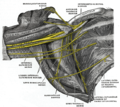| Median nerve | |
|---|---|
 Diagram from Gray's anatomy, depicting the peripheral nerves of the upper extremity, amongst others the median nerve | |
| Details | |
| From | Lateral cord and medial cord |
| Innervates | Anterior compartment of the forearm (with two exceptions), thenar eminence, lumbricals, skin of the hand |
| Identifiers | |
| Latin | nervus medianus |
| MeSH | D008475 |
| TA98 | A14.2.03.031 |
| TA2 | 6459 |
| FMA | 14385 |
| Anatomical terms of neuroanatomy | |
The median nerve is a nerve in humans and other animals in the upper limb. It is one of the five main nerves originating from the brachial plexus.
Contents
- Structure
- Arm
- Forearm
- Hand
- Variation
- Function
- Arm 2
- Forearm 2
- Hand 2
- Clinical significance
- Injury
- Assessment
- Additional images
- See also
- References
- External links
The median nerve originates from the lateral and medial cords of the brachial plexus, [1] and has contributions from ventral roots of C6-C7 (lateral cord) and C8 and T1 (medial cord). [1] [2]
The median nerve is the only nerve that passes through the carpal tunnel. Carpal tunnel syndrome is the disability that results from the median nerve being pressed in the carpal tunnel.











